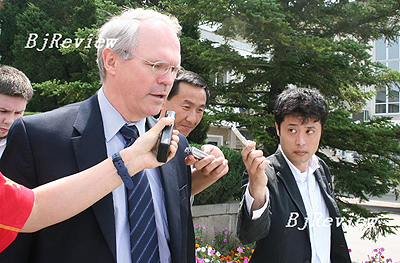
The Bush administration is exploring how to implement a peace accord to officially end the Korean War (1950-53), according to a recent report on The Wall Street Journal's website, which quoted unidentified senior U.S. officials.
Christopher Hill, U.S. Assistant Secretary of State for East Asian and Pacific Affairs and head of the U.S. delegation to the six-party talks, said that the Bush administration hoped to start discussions with North Korea on a formal peace treaty before the end of this year if North Korea began to honor its commitments, the report said.
But this is not the first time that U.S. officials have made known their intention. During a meeting with Chinese President Hu Jintao last November, U.S. President George W. Bush contemplated adopting a declaration to end the Korean War. On June 25, Hill said that the parties involved possibly could negotiate a peace treaty directly with North Korea if North Korea started to demolish its nuclear reactor.
After the United States released North Korea's long frozen funds in late June, Pyongyang indicated that it would soon undertake its obligations under the joint document signed on February 13 at the end of the fifth round of the six-party talks aimed at resolving the North Korean nuclear crisis.
North Korea's Foreign Ministry confirmed on July 15 that the country shut down its Yongbyon nuclear facility the day before, after it received the first shipment of 6,200 tons of heavy fuel oil from South Korea.
In the eyes of the United States, conditions for discussing a peace accord are being created as all these signs show that North Korea has begun to honor its commitments.
The Korean War Armistice Agreement is the current accord maintaining stability on the Korean Peninsula. After three years of hot war, the agreement was signed on July 27, 1953, by the supreme commander of the Korean People's Army, the commander of the Chinese People's Volunteers and the commander in chief of the United Nations Command. Although the agreement has not been viewed as a satisfactory solution over the decades, it has largely served the purpose of ceasing military operations, maintaining the status quo of the military demarcation line and creating peace in the context of confrontation.
North Korea has long hoped to sign a peace accord with the United States to replace the armistice agreement, thereby formally ending the war, and has sought to establish diplomatic relations with the United States.
But the United States consistently has rejected this option. Ideology is part of the reason. The United States does not like the systems that North Korea has adopted. U.S. strategic considerations in East Asia are another reason. American military presence in South Korea will be more difficult to justify after a peace agreement is signed.
The United States has other practical concerns as well. For example, the country and South Korea have a military alliance treaty, while North Korea and South Korea are still embroiled in confrontation. If it signs a peace treaty with North Korea, it will be caught in a dilemma of whether to provide assistance to South Korea in the event of a war on the Korean Peninsula.
North Korea took steps to paralyze the armistice agreement in the early 1990s in its bid to pressure the United States. Article II of the agreement prescribes the establishment of a Military Armistice Commission and a Neutral Nations Supervisory Commission. However, since March 1991 North Korea has refused to attend the Military Armistice Commission's meetings. It also demanded that China withdraw its delegation of the Chinese People's Volunteers to the commission stationed in Panmunjom by the end of April 1994.
In May 1994, North Korea unilaterally declared the creation of the Panmunjom Mission of the Korean People's Army. As a result, the Military Armistice Commission collapsed. North Korea also forced the Czech Republic and Poland to withdraw their representatives from the Neutral Nations Supervisory Commission in 1993 and 1995, respectively, leaving the commission unable to operate.
| 